Jackie Damrau, Editor
Futura: The Typeface
by Petra Eisele, Annette Ludwig, and Isabel Naegele, eds.
Understanding Rhetoric: A Graphic Guide to Writing
by Elizabeth Losh, Jonathan Alexander, Kevin Cannon, and Zander Cannon
Thinking Through Communication: An Introduction to the Study of Human Communication
by Sarah Trenholm
We Are Data: Algorithms and the Making of Our Digital Selves
by John Cheney-Lippold
Organizing for Creative People: How to Channel the Chaos of Creativity into Career Success
by Sheila Chandra
Working Virtually: Transforming the Mobile Workplace
by Trina Hoefling
Scientific and Medical Communication: A Guide for Effective Practice
by Scott A. Mogull
Theory of User Engineering
by Masaaki Kurosuorg
Presenting Data Effectively: Communicating Your Findings for Maximum Impact
by Stephanie D. H. Evergreen
The Online Journalism Handbook: Skills to Survive and Thrive in the Digital Age
by Paul Bradshaw
What Editors Do: The Art, Craft, and Business of Book Editing
by Peter Ginna, ed.
FrameMaker – Working with Content
by Matt R. Sullivan
Topic-Driven Environmental Rhetoric
by Derek G. Ross, ed.
Draft No. 4: On the Writing Process
by John McPhee
Now You See It and Other Essays on Design
by Michael Bierut
Never Use Futura
by Douglas Thomas
Out of the Ruins: The Emergence of Radical Informal Learning Spaces
by Robert H. Haworth and John M. Elmore, eds.
Communicating Genetics: Visualizations and Representations
by Han Yu
Graphic Design Discourse: Evolving Theories, Ideologies, and Processes of Visual Communication
by Henry Hongmin Kim, ed.
This Book is a Planetarium and Other Extraordinary Pop-Up Contraptions
by Kelli Anderson
Visual Journalism: Infographics from the World’s Best Newsrooms and Designers [English Translation]
by Javier Errea, ed.
How to Write and Present Technical Information
by Charles Sides
Making Books: A Guide to Creating Handcrafted Books
by London Centre for Book Arts
A World without “Whom”: The Essential Guide to Language in the BuzzFeed Age
by Emmy J. Favilla
Take My Money: Accepting Payments on the Web
by Noel Rappin
Futura: The Typeface
Petra Eisele, Annette Ludwig, and Isabel Naegele, eds. 2017. London, United Kingdom: Laurence King Publishing. [ISBN 978-1-78627-093-1. 520 pages, including index. US$65.00.]
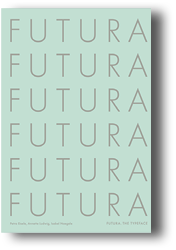 Futura: The Typeface is a comprehensive history of Futura, a typeface initially proposed by German designer Paul Renner in 1924. The book is a collection of essays provided by a range of well-known and influential writers about design and design history, such as contributors Steven Heller and Erik Speikermann. The book was originally developed as a catalogue to support an exhibition of the Futura typeface at the Gutenberg Museum of Mainz, Germany (p. 19). The book is so much more than a catalogue; indeed, it provides a cultural history of an era through the lens of one of the world’s most ubiquitous and enduring fonts.
Futura: The Typeface is a comprehensive history of Futura, a typeface initially proposed by German designer Paul Renner in 1924. The book is a collection of essays provided by a range of well-known and influential writers about design and design history, such as contributors Steven Heller and Erik Speikermann. The book was originally developed as a catalogue to support an exhibition of the Futura typeface at the Gutenberg Museum of Mainz, Germany (p. 19). The book is so much more than a catalogue; indeed, it provides a cultural history of an era through the lens of one of the world’s most ubiquitous and enduring fonts.
It may seem amazing to some that there exists a 500-page book on the history of a typeface. Futura, however, is entrenched in the history of Europe, especially Germany, beginning in the 1920s onward. Futura is a journey through time and place, beginning with the design and development of the font by Renner and continuing with its influence in major cities such as Frankfurt, Hannover, Berlin, and Munich. The book then travels outside of Germany to show the typeface’s influence in places such as Vienna, Prague, Paris, and New York. Included is also a mention of the typeface’s history and current position on the moon.
Futura describes the typeface’s extensive use since its inception, such as its prevalent use in urban planning in the city of Frankfurt. However, the font is most commonly relegated to the fields of advertising and book design. While the book includes an impressive vertical history of the typeface, it also includes an astonishing horizontal history of involved events and people, detailing biographies of not only Renner himself but also highlighting those involved with its production and marketing at the Bauer typefoundry, as well as the purveyors of its use.
This horizontal history even discusses the political implications of Futura. Originally dismissed by the Nazis and the Third Reich as part of the degenerative art movements of the New Architecture and New Typography, it was later adopted for official use by the party. The book explains the initial dismissal as well as the change of heart and how this shift correlated with a change in the political climate of Germany during World War II.
Originally intended to be, and marketed as, the typeface of the future, Futura also drew inspiration form the past. Futura: The Typeface is long but not a difficult book to read, and it is accompanied by an abundance of informative images showing the development and use of the typeface in various locations and throughout time, including many historical images of Futura in advertising and design by big name designers such as Paul Rand, Jan Tschichold, Herbert Bayer, and more. Although a book on the history of a font may seem to have a limited audience appeal, mostly to historians, designers, typographers and type enthusiasts, it is, however, a history that cultural anthropologists will be pleased with as well.
Amanda Horton
Amanda Horton holds an MFA in Design and currently teaches graduate and undergraduate courses at the University of Central Oklahoma in the areas of design technology, design studio, and history of graphic design. Ms. Horton is also the director of the Design History minor at UCO.
Understanding Rhetoric: A Graphic Guide to Writing
Elizabeth Losh, Jonathan Alexander, Kevin Cannon, and Zander Cannon. 2017. 2nd ed. Boston, MA: Bedford/St. Martin’s. [ISBN 978-1-319-04213-4. 340 pages, including index. US$54.99 (softcover).]
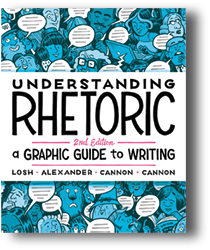 In Understanding Rhetoric: A Graphic Guide to Writing, authors Elizabeth Losh and Jonathan Alexander team up with graphic artists Kevin Cannon and Zander Cannon to create a writing guide in the form of a graphic novel. With the constant presence of social media in our lives, visual literacy is more important now than ever before. Losh and Alexander’s concise explanations of fundamental concepts for writing, like how using new media might complicate and enrich the composition and publishing of documents, make this book worth reading for technical communicators living in an increasingly visual world.
In Understanding Rhetoric: A Graphic Guide to Writing, authors Elizabeth Losh and Jonathan Alexander team up with graphic artists Kevin Cannon and Zander Cannon to create a writing guide in the form of a graphic novel. With the constant presence of social media in our lives, visual literacy is more important now than ever before. Losh and Alexander’s concise explanations of fundamental concepts for writing, like how using new media might complicate and enrich the composition and publishing of documents, make this book worth reading for technical communicators living in an increasingly visual world.
This book illustrates compelling examples from history to teach the concepts of writing. For example, to help explain the importance of critical reading, Cannon and Cannon draw out the “ferocious beasts of the forest” that Frederick Douglass uses to describe kidnappers of runaway slaves (p. 75). Because the examples are so entertaining, it is easy to forget how much material the book covers. In “Introduction: Spaces for Writing,” Losh and Alexander set up the book’s main concerns, such as the contexts for writing, the writing process, and visual literacy. “Issue 1: Why Rhetoric?” gives a general overview of rhetoric, along with a general history that sticks to the familiar ground of the ancients and ethos, pathos, and logos. “Issue 2: Strategic Reading” offers strategies for critically reading texts. “Issue 3: Writing Identities” deals with the issues of writing for different audiences and the notions of the performer. “Issue 4: Argument Beyond Pro and Con” delves into strategies for argument that go beyond the basics. “Issue 5: Composing Together” focuses on writing with other people. “Issue 6: Research: More Than Detective Work” discusses how to find good sources and how to cite them. “Issue 7: Rethinking Revision” directs the reader toward structural revision instead of just looking for typos. “Issue 8: Going Public” deals with issues of publication in the world of the Internet.
Understanding Rhetoric also uses helpful stories at the end of each chapter to help put the theories into the context of real-world situations. Although the book may feel a little “young” for some technical communicators, the abundance of useful information about writing and helpful examples make the book worth reading. This book is a fun, yet challenging refresher on the fundamentals of writing that also establishes its place in this increasingly visually oriented world.
Dylan Schrader
Dylan Schrader is a graduate student in the MA in Professional Communication program at the University of Alabama in Huntsville, where he also works as a grant researcher in the Office for Proposal Development.
Thinking Through Communication: An Introduction to the Study of Human Communication
Sarah Trenholm. 2018. 8th ed. New York, NY: Routledge. [ISBN 978-1-138-23390-4. 418 pages, including index. USD$145.99 (softcover).]
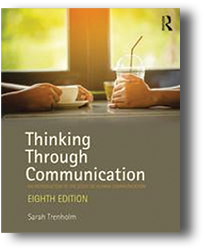 Trenholm’s Thinking Through Communication: An Introduction to the Study of Human Communication introduces students to communication and its role in society. It is the type of textbook that explains concepts rather than offers how-to-do something. The book begins with a brief overview of communication and its history (Chapters 1 and 2), and then moves to listening and language (Part II; 3 chapters) and channels and contexts (Part III; 7 chapters). Students will learn about specialized aspects of communication, such as group communication (Chapter 8), organizational communication (9), public communication (10), mass communication (11), and intercultural communication (12), as well as fundamental elements, such as listening, spoken language, nonverbal communication, communicating in a wired world, and interpersonal communication.
Trenholm’s Thinking Through Communication: An Introduction to the Study of Human Communication introduces students to communication and its role in society. It is the type of textbook that explains concepts rather than offers how-to-do something. The book begins with a brief overview of communication and its history (Chapters 1 and 2), and then moves to listening and language (Part II; 3 chapters) and channels and contexts (Part III; 7 chapters). Students will learn about specialized aspects of communication, such as group communication (Chapter 8), organizational communication (9), public communication (10), mass communication (11), and intercultural communication (12), as well as fundamental elements, such as listening, spoken language, nonverbal communication, communicating in a wired world, and interpersonal communication.
Each chapter follows a similar pattern. After an overview followed by the chapter’s text, you’ll find a summary, a list of key terms, and suggested readings. Two appendices follow a similar pattern. Chapters also have lists of what you should know after reading the chapter. Such lists help the reader focus on the key elements.
The emphasis in Thinking Through Communication is on communication, its history, and the various types of communication. Advice on preparing and giving oral presentation does not come until Appendix A. It offers material on planning and delivery as well as the speaker’s needed skills and responsibilities. Appendix B covers research methods—five are described in detail.
I was disappointed to find nothing on business and technical communication. The content of first-year writing classes has changed over the years, and you can find elements of business and technical communication principles addressed; for example, résumés, cover letters, interviews, descriptions, etc.
A second disappointment was no discussion of visuals; certainly, support via visuals is a major part of all communication. Trenholm’s approach through rhetoric focuses on rhetorical elements without discussing visuals.
The subtitle states her purpose: An Introduction to the Study of Human Communication. Yet “speech communication” appears frequently throughout the text.
This book has some other oddities. First, there are no standard materials for the students, such as chapter questions, assignments, etc. Rather, there is the material contained in the list of things the student should be able to do after reading the chapter. Second, these and other teaching aids are available through an instructor resource website. Finally, although it does present five communication theories (while emphasizing the social construction of reality), students would need additional materials to grasp the range of approaches to understand communication fully.
Because the material is focused on an introduction to communication and not on specialized communication, much of Thinking Through Communication will not be appropriate. However, if you want more general knowledge of communication with a side helping of advice on making oral presentations, this book may prove useful.
Tom Warren
Tom Warren is an STC Fellow, Jay R. Gould Award for Excellence recipient, and professor emeritus of English (technical writing) at Oklahoma State University, where he established the BA, MA, and PhD technical writing programs. Past president of INTECOM, he served as guest professor at the University of Paderborn, Germany.
We Are Data: Algorithms and the Making of Our Digital Selves
John Cheney-Lippold. 2017. New York, NY: New York University Press. [ISBN 978-1-4798-5759-3. 318 pages, including index. US$27.95.]
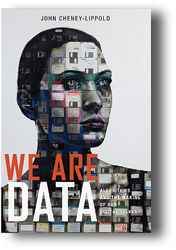 We Are Data: Algorithms and the Making of Our Digital Selves is an in-depth look at how our lives are intrinsically driven by data. Every minute of every day, our digital “identity” is developed with every Google search, every online purchase, and every comment/like/post to a social network. Every click of the mouse (or tap of a finger) feeds various corporations information about us. Those corporations use that data to identify us, but we have no control or knowledge of that identity. For example, visiting a home improvement store’s website may gender you as male, whether you are or not. According to Cheney-Lippold, “The different layers of who we are online, and what who we are means, is decided for us by advertisers, marketers, and governments. And all these categorical identities are functionally unconcerned with what, given your own history and sense of self, makes you you” (p. 7). We have no control over how corporations interpret the data we feed to them through our online activity.
We Are Data: Algorithms and the Making of Our Digital Selves is an in-depth look at how our lives are intrinsically driven by data. Every minute of every day, our digital “identity” is developed with every Google search, every online purchase, and every comment/like/post to a social network. Every click of the mouse (or tap of a finger) feeds various corporations information about us. Those corporations use that data to identify us, but we have no control or knowledge of that identity. For example, visiting a home improvement store’s website may gender you as male, whether you are or not. According to Cheney-Lippold, “The different layers of who we are online, and what who we are means, is decided for us by advertisers, marketers, and governments. And all these categorical identities are functionally unconcerned with what, given your own history and sense of self, makes you you” (p. 7). We have no control over how corporations interpret the data we feed to them through our online activity.
Our data are made into “measurable types,” such as race, gender, ethnicity, etc., and the soft biopolitics of the algorithms used to determine those measurable types. Cheney-Lippold argues that the corporations (or owners) of data have control and determine the truth of that data. To this point, he writes “What we and knowledge become is not a function of truth. It’s a function of the algorithm’s output that we are told is ‘truth’” (p. 91). These “truths” frame our world and conditions the possibilities available to us. For example, Google will return search results based on Google’s interpretation of your data/identity further enforcing that identity.
Our digital identities, however, are not created from our data alone. For “a single piece of data means nothing on its own” and only has meaning when compared to masses of other data (p. 199). Algorithms are built from the data of others in which patterns of likeness determine how ours (and others) digital identities are understood. In conclusion, We Are Data shows us just how powerful data can be and how that data affects who we are and who we can be. Cheney-Lippold addresses how data is (and always has been) a part of our lives through the discussion of categorization, control, subjectivity, and privacy.
Sara Buchanan
Sara Buchanan is an STC member that serves as the NEO STC community newsletter editor and is the membership manager for the IDL SIG. She is a technical writer at LCS is Cincinnati, OH for the software, Rent Manager.
Organizing for Creative People: How to Channel the Chaos of Creativity into Career Success
Sheila Chandra. 2017. London, England: Watkins Publishing. [978-1-78678-022-5. 278 pages. US$16.95.]
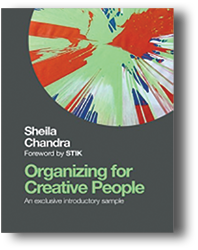 How would you like an organizing book that covers how to organize “every” aspect of your life…physical space and headspace? Chandra delivers just that with her book, Organizing for Creative People: How to Channel the Chaos of Creativity into Career Success.
How would you like an organizing book that covers how to organize “every” aspect of your life…physical space and headspace? Chandra delivers just that with her book, Organizing for Creative People: How to Channel the Chaos of Creativity into Career Success.
She wrote the book for Stik, a homeless street artist. Stik has since gone on to become one of the most famous, collectible street artists in the world. Chandra detailed for Stik the necessary areas in the physical space and headspace that should be organized for his success. As a reader, whether you are part of a business set-up or work for a large company, you, too, can benefit by applying her suggestions, which include:
- Your work area“Make your workspace be an extension of your body” (p. 31). You should reach for what you need without thinking. I do this by using a vertical file organizer that I keep on my desk. I have a colored file folder for each of my projects and I keep the latest work in the folders.One of seven items she recommends using in the office is an A5 spiral-bound notebook. Use this to keep a daily running master list of both work and home tasks. As you complete each task, cross it off the list.At the start of each day, review your plan for the day and make certain you have allocated enough time for each task. Don’t forget to include a mini-break every half hour, which will increase your efficiency.If you are uncertain when your most productive times of your day are, do a time log. Determine when your most creative times of the day are and schedule your work around those times.Chandra recommends keeping a clear desk and only having the materials you need for your current task on your desktop. Otherwise, your brain cannot clearly focus on the task at hand.
- Your careerPlan your work life with a yearly work calendar. Select two goals and plan out over the next year how you will achieve them and log milestones for them either monthly or quarterly. That way, you’ll have a better chance of achieving them.Chandra suggests creating a five-year vision and writing it out, along with the date. This will help you make decisions regarding your career. Also, your subconscious mind wants to know where you are and where you’re going.
I highly recommend Organizing for Creative People: How to Channel the Chaos of Creativity into Career Success if you are looking to organize your workspace and get a better focus on your goals.
Rhonda Lunemann
Rhonda Lunemann is a technical writer with Siemens PLM Software and is a senior member of STC’s Twin Cities Chapter. She assists in arranging programs for the Twin Cities Chapter.
Working Virtually: Transforming the Mobile Workplace
Trina Hoefling. 2017. 2nd ed. Sterling, VA: Stylus Publishing. [978-1-62036-292-1]. 264 pages, including index. US$29.95 (softcover).
 Hoefling laments that business and industry are failing to prepare employees for adapting to a new workplace evolution and that employee engagement (the finesse required to win hearts and minds) continues to erode. In her new edition, she stresses the radical changes inherent in our technologically driven work place—including increasingly specialized project work that will demand contingent and contract workers who rotate on and off teams with regularity. Working Virtually: Transforming the Mobile Workplace is organized into 19 chapters and six parts, each averaging three chapters, and each introduced with relevant quotes by novelists, athletes, presidents, poets, and philosophers.
Hoefling laments that business and industry are failing to prepare employees for adapting to a new workplace evolution and that employee engagement (the finesse required to win hearts and minds) continues to erode. In her new edition, she stresses the radical changes inherent in our technologically driven work place—including increasingly specialized project work that will demand contingent and contract workers who rotate on and off teams with regularity. Working Virtually: Transforming the Mobile Workplace is organized into 19 chapters and six parts, each averaging three chapters, and each introduced with relevant quotes by novelists, athletes, presidents, poets, and philosophers.
Hoefling writes with figurative language that make her message both relatable and inspiring, particularly when she refers to workers who grapple with “information anorexia or obesity” (p. 189). She borrows the central theme in her book from a Buddhist metaphor, an approach to virtual teaming she calls the “Threefold Path for high-performing teams” (p. 6). Embarking on this path begins after assembling a team with the requisite knowledge, skills, and aptitude. The hard work begins with guiding the team toward negotiating shared values, norms, and structure that establish and maintain trust, which is essential for a virtual team to thrive.
The second half of Hoefling’s book covers the richest information, including optimizing technology for communication and outlining recommendations for getting the best out of team members. Meeting project timelines and producing deliverables, particularly on a virtual team, requires relationships and bonds that afford a sense of camaraderie. High-performing teams celebrate and champion finding solutions to problems and overcoming obstacles. Hoefling points to the spiritual nature of collective effort at its best, and devotes several paragraphs to the notion of the “sacred (virtual) space” of a high-performing team (p. 207).
She gives attention to generational differences and their effects on virtual teams, crediting millennials with the aptitudes and proclivities for this new way of working. Hoefling also touches upon diversity in virtual teams, including the traits of introversion and extroversion, but she doesn’t address gender, racial, ethnic, cultural, political, or ideological differences common among global virtual teams. Themes that recur in each chapter, including communication protocols, trust, and structure, make some of the content seem redundant at times, but the redundancy keeps these nuances of team dynamics central to the book’s message and purpose.
Hoefling offers supplemental materials on her website, including a free bonus chapter on virtual meetings. Her book chapters include checklists, assessments, and criteria to help with the more practical aspects of virtual teaming. The book, however, could benefit from more examples from Hoefling’s experiences and case studies that would have made the material more concrete for readers.
Whether you are part of a co-located, distributed, or virtual team, Working Virtually will help you increase productivity, improve employee engagement, and reap both the intrinsic and extrinsic rewards of the working on high-performing virtual teams.
Allen Brown
Allen Brown is managing director of operations for the Marriott Foundation for People with Disabilities. He holds an M.S. in Technical Communication Management from Mercer University.
Scientific and Medical Communication: A Guide for Effective Practice
Scott A. Mogull. 2018. New York, NY: Routledge. [ISBN 978-1-138-84255-7. 360 pages, including index. US$59.85 (softcover).]
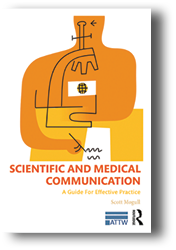 In Scientific and Medical Communication: A Guide for Effective Practice, Mogull provides a comprehensive guide designed to “prepare individuals to write and edit scientific manuscripts, conference abstracts, posters, and press releases” as well as to conduct database searches and to use the appropriate citation format (p. i). This book is the fourth in the Association of Teachers of Technical Writers Book Series in Technical and Professional Communication.
In Scientific and Medical Communication: A Guide for Effective Practice, Mogull provides a comprehensive guide designed to “prepare individuals to write and edit scientific manuscripts, conference abstracts, posters, and press releases” as well as to conduct database searches and to use the appropriate citation format (p. i). This book is the fourth in the Association of Teachers of Technical Writers Book Series in Technical and Professional Communication.
Scientific and medical communication (SMC) has long been viewed as one of the most difficult genres in technical communication because it requires specialized knowledge and often employs quantitative methods. The amount of knowledge necessary to write or edit in these fields can be overwhelming. As a result, graduate students and practitioners tend to be less likely to choose SMC as a concentration. These audiences might change their mind if they are armed with Mogull’s book, which makes this communication type seem simple and easy to understand.
Scientific and Medical Communication is well organized and employs the techniques that it teaches: clear writing and structured communication. Each section focuses on a genre within SMC, such as journal articles, posters, and press releases. This straightforward organization allows the reader to focus on the genre that is most relevant to them, or to read the entire book from cover to cover for a thorough knowledge of all the possible methods of communication in this field.
Each chapter covers the essential information needed for each section of the paper or presentation, highlighting the necessary “moves” or subsections needed to provide the audience with a thorough understanding of the topic. The chapters are rich with practical examples pulled from the scientific and medical community. The extensive examples contain annotation to illustrate Mogull’s points. Another aspect of the chapters that I found helpful was the sections about common errors and pitfalls. These sections serve as helpful checklists as writers write and revise their work.
Perhaps the most outstanding aspect of Scientific and Medical Communication was the use of sources. Many practical guides tend to rest on the author’s authority. While Mogull certainly might have gone that route with his expertise, he chose instead to model what he teaches in the text and support his claims with references from all related fields, such as Tufte for the section on visual communication and Strunk for the section on writing style. Some of these technical communication sources rarely make it in to the discourse of scientists or medical practitioners.
Scientific and Medical Communication is a valuable guide for graduate students in technical communication, as well as the health and scientific fields. However, it is a useful resource for practicing technical communication professionals and academics. Much of the information contained in this text is well known to technical communicators who have been working in this field for years. However, having the information broken down into an easy-to-use guide clarifies some of the practice, as well as provides helpful tips for teaching research techniques and scientific writing.
Nicole St. Germaine-Dilts
Nicole Dilts is an Associate Professor in the Technical and Business Writing Program at Angelo State University, as well as a freelance medical writer. Her research interests include technical communication for a Spanish-speaking audience and technical communication in the health fields.
Theory of User Engineering
Masaaki Kurosu. 2017. Boca Raton, FL: CRC Press. [ISBN 978-1-4822-3902-7. 132 pages, including index. US$89.95.]
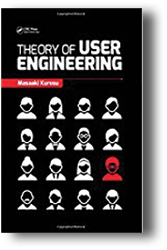 Theory of User Engineering offers a comprehensive overview of Kurosu’s insights and opinions about the field. The book’s description promises new concepts, which it did not deliver. The book is separated into three main sections with the first two chapters comprising almost half the book (46 pages). They focus on the theory of user engineering. The second part of the book delves into practical applications used for defining artifacts, designing processes, conducting user research, and specifying requirements. The last two chapters review current trends and speculate about the future.
Theory of User Engineering offers a comprehensive overview of Kurosu’s insights and opinions about the field. The book’s description promises new concepts, which it did not deliver. The book is separated into three main sections with the first two chapters comprising almost half the book (46 pages). They focus on the theory of user engineering. The second part of the book delves into practical applications used for defining artifacts, designing processes, conducting user research, and specifying requirements. The last two chapters review current trends and speculate about the future.
In the first section, Kurosu spends significant time differentiating between terms. He starts the book by defining user engineering as “a set of concepts and methods for improving the quality of life of users” (p. 1). He differentiates that from user experience design, which he says is oriented toward marketing. Several of his sections return to the differences between terms. For example, when describing human-centered design, Kurosu says, “If marketing people and manufacturers are included in ‘human,’ the design approach will be the one that focuses on the product and the service that will bring a big profit to them regardless of whether such artifacts are beneficial to the user” (p. 17). His pointed descriptions may stem back to a 2007 comment from Don Norman (author of The Design of Everyday Things) that Kurosu references on page 22. He quotes Norman explaining that “user experience” has become a diluted term that has lost special meaning. Theory of User Engineering spends an unfortunate amount of time delineating between terms like user interface/user experience (UI/UX), UX, user-centered design, and human-centered design. I appreciate its gusto for the specific differences in the terms, but the arguments were not strong enough for me to care.
Although the book promised new user engineering concepts, many of the sections do not expand on existing practices and theories. That said, the first two chapters included strong explanations of users as well as relevant summaries about ISO standards and usability concepts. Chapters three to 10 provide great step-by-step explanations and instructions for conducting fruitful user research. This book was cited very well. It referenced existing usability research that supported its objectives. The graphs and charts were done well. They were simple, basic, black-and-white examples that reinforced the messages or provided good supporting explanations that added clarity.
Theory of User Engineering may be a useful text for a student or someone new to the field. But I did not think that it delivered the new concepts that were promised in the description.
Stephanie Saylor
Stephanie Saylor is an STC member and a senior technical writer with the UX team at Next Century Corporation. She received her master’s degree in digital communication from Johns Hopkins University.
Presenting Data Effectively: Communicating Your Findings for Maximum Impact
Stephanie D. H. Evergreen. 2018. 2nd ed. Thousand Oaks, CA: Sage Publications. [ISBN 978-1-5063-5312-8. 226 pages, including index. US$58.00 (softcover).]
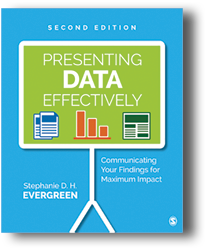 On the job, we don’t have the luxury of time to convey information or make an argument. Managers expect instant answers, quick solutions as bulleted lists, and professionally presented data to help us keep pace with today’s business in what one designer calls a “high concept” society, meaning you have “about three seconds to capture attention” (p. 34). Thanks to contemporary applications from Microsoft Office to the Adobe Creative Suite, nearly every worker is expected to produce professional-quality materials. The trick is, How?
On the job, we don’t have the luxury of time to convey information or make an argument. Managers expect instant answers, quick solutions as bulleted lists, and professionally presented data to help us keep pace with today’s business in what one designer calls a “high concept” society, meaning you have “about three seconds to capture attention” (p. 34). Thanks to contemporary applications from Microsoft Office to the Adobe Creative Suite, nearly every worker is expected to produce professional-quality materials. The trick is, How?
Presenting Data Effectively: Communicating Your Findings for Maximum Impact is an indispensable text for anyone who doesn’t have a design background but who needs to create quality products, particularly reports, dashboards, and presentations. The second edition is a spectacular upgrade with full color throughout and a sleek page layout that makes absorbing the content a breeze.
Evergreen begins with an argument for design, including recent research on “[v]isual processing theory,” which “describes the way the brain perceives and interprets what the eyes see” (p. 18). This information can help readers make a case for design upgrades, especially to those who discount good design as “trying to look slick” (p. 197).
She then categorizes design into four chapters that cover graphics, text, color, and arrangement. Each chapter begins with learning objectives and conceptual information with clear definitions and examples followed by detailed procedures for how to apply the concepts to your projects. Chapters end with a “bottom line” summary, a bullet list of key points, suggestions for extending the concepts, and a reference list for more information.
Presenting Data Effectively also includes two checklists for report layout and data visualization—great for students learning to write reports as well as those in business. The book’s companion website, unfortunately, doesn’t have much useful content, only a few documents described in the text, but the links at the end of each chapter are treasure troves to online content. Evergreen’s approach “is about reworking our data so that it can be understood” (p. 197), and every chapter delivers.
Throughout the text, the procedures focus on Microsoft Office applications because of their ubiquity. Examples include large, full-color screen shots and clear directions for using features like styles in Word. Even more sophisticated users might appreciate some of the tips, like how to reduce file size (p. 64) or use a dark, but thin, border to distinguish lighter elements on the page (p. 144).
Besides all the graphical elements, the writing is conversational in tone. For example, when discussing the pitfalls of a single-page dashboard meant to help people make decisions from overly simplistic graphics, Evergreen writes, “And this is when the research team freaks out….Yikes, please don’t make decisions from this quite yet” (p. 17). She then argues for a dashboard report of a few pages that combine the visuals of a dashboard with slightly more writing to provide context.
Kelly A. Harrison
Kelly A. Harrison, MFA, teaches writing at San José State University and Stanford University. She has written print and online content for various high-tech companies.
The Online Journalism Handbook: Skills to Survive and Thrive in the Digital Age
Paul Bradshaw. 2018. 2nd ed. New York, NY: Routledge. [ISBN 978-1-138-79156-5. 358 pages, including index. US$55.95 (softcover).]
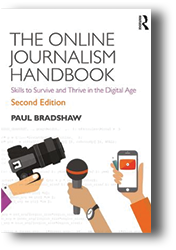 The Online Journalism Handbook: Skills to Survive and Thrive in the Digital Age walks readers through the various aspects of journalists’ online activity, with suggested activities and further readings at the end of each chapter. Each topic covered is summarized, including a brief history, and often includes detailed instructions on how to do certain things, from spreadsheet formulas for data journalism to using advanced search operators to narrow down online information. Sidebars provide case studies, interviews, and more in-depth information on various platforms, such as Twitter.
The Online Journalism Handbook: Skills to Survive and Thrive in the Digital Age walks readers through the various aspects of journalists’ online activity, with suggested activities and further readings at the end of each chapter. Each topic covered is summarized, including a brief history, and often includes detailed instructions on how to do certain things, from spreadsheet formulas for data journalism to using advanced search operators to narrow down online information. Sidebars provide case studies, interviews, and more in-depth information on various platforms, such as Twitter.
As with most books, online services change faster than the publishing cycle. The “Closer Look: Twitter” sidebar, for example, discusses in detail that service’s 140-character limit and ways to work around it. The book is copyrighted in 2018, but in late 2017, Twitter raised its limit to 280 characters. Similarly, some of the apps or brands mentioned may have changed drastically, or no longer exist, by the time you read this.
Another caveat is the handbook’s British origin. Although most examples from The Guardian and similar publications are equally applicable in the US, the guest-written chapter on media law is of limited use outside the European Union—or indeed outside the United Kingdom, given that country’s impending departure from the union.
Most other advice, however, is not tied to location. For example, chapters on online audio and video provide detailed advice on equipment, planning, and recording the sound and/or images. Other chapters address the changing nature of journalism with the advent of online capabilities, using the Internet to find sources and story ideas, writing for online consumption or social media, reporting on the go without a TV news van and technical staff, basic coding skills and adding interactive features to online coverage, and incorporating user-generated content in reporting.
Beyond helping journalism students and others interested more in words than technology navigate the production of digital news, Bradshaw also explains how to verify online information, such as checking images for tampering. As we must sort through ever more news, some of which may be of dubious veracity, this is becoming an important skill even for non-journalists. The basic HTML knowledge that Bradshaw advocates is useful here to determine, for example, whether a webpage resides at its purported URL or redirects elsewhere.
The Online Journalism Handbook provides a good overview of the various types of online news that journalists are asked to produce today. Nobody can create these, but some of the suggested exercises may help in picking one or two areas for in-depth.
Barbara Jungwirth
Barbara Jungwirth owns reliable translations llc (www.reliable-translations.com), where she translates technical documents from German into English. She was previously a technical writer and IT manager and currently serves on the board of STC’s New York Metro chapter. Barbara writes a blog (On Language and Translation) and tweets (@reliabletran).
What Editors Do: The Art, Craft, and Business of Book Editing
Peter Ginna, ed. 2017. Chicago, IL: The University of Chicago Press. [ISBN 978-0-226-29997-6. 310 pages, including index. US$25.00 (softcover).]
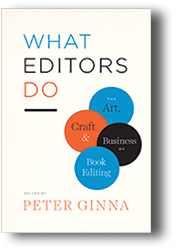 Ginna’s edited collection of essays joins more than 100 other titles in the Chicago Guides to Writing, Editing, and Publishing series, which also includes such excellent aids for editors as Bryan A. Garner’s The Chicago Guide to Grammar, Usage, and Punctuation (2016), Scott Norton’s Developmental Editing (2009), and Carol Fisher Saller’s The Subversive Copy Editor (2016).
Ginna’s edited collection of essays joins more than 100 other titles in the Chicago Guides to Writing, Editing, and Publishing series, which also includes such excellent aids for editors as Bryan A. Garner’s The Chicago Guide to Grammar, Usage, and Punctuation (2016), Scott Norton’s Developmental Editing (2009), and Carol Fisher Saller’s The Subversive Copy Editor (2016).
What Editors Do: The Art, Craft, and Business of Book Editing includes 26 chapters that expand upon the editorial functions of acquisition, text development, and publication. Some contributors are familiar names in publishing: Norton, Jane Friedman, and Katherine O’Moore-Klopf, for example. Whether a writer be a book author, executive manager, editorial director, publisher, agent, columnist, teacher, freelance editor, in-house editor, or CEO, all are long-established experts.
The essays focus mainly on editing within publishing houses. The general pattern of who does what and on what schedule is much the same whether we’re looking at a work of literary fiction or a textbook being submitted to a publisher. Chapters devoted to literary publications may seem only indirectly related to technical communication, but even those pages offer insights of value to technical editors.
It’s impossible to avoid some duplication of topic among the essays. Thus, different voices tell us about acquisition editors, developmental editing, the promises and threats posed by Amazon and other realities of the digital age, economics and marketing, self-publishing, and more.
Useful descriptions and recommendations abound. Norton, for example, details how you, the developmental editor, can avoid authors who won’t appreciate your suggestions as well as manuscript reviewers whose comments will bog down the development process. Saller briskly describes the varied work of copyeditors, emphasizing “Do no harm.” Deb Aaronson writes, “Illustrated books are . . . defined by . . . the capacity of that subject to be expressed visually” (p. 214); we can apply this insight in many ways in our work.
Katie Henderson Adams writes on working as an editorial assistant—a perspective unduly ignored in the literature on editing. O’Moore-Klopf offers a sobering analysis of the minuses as well as the plusses of freelance editing. Arielle Eckstut and David Henry Sterry’s “The Self-Publisher as Self-Editor” is excellent on taking criticism. Friedman explains how to craft the optimum metadata for a book and use such tools as Kindle Worlds and Wattpad to build relationships.
The glossary is notable for its compact definitions, strict relevance to editors’ needs, and inclusion of such newer terms as agile publishing. We find, in addition, a handy selective, partially annotated list of resources and an excellent index.
One indication of Ginna’s own editorial expertise is that Norton and Saller here write about developmental editing and copyediting without repeating the content of their own books. Also, he has kept all chapters roughly the same length.
Ginna has taken pains to describe the realities of editing without sentimentalizing the work. He echoes my thoughts about editing as a profession: “Editing is a noble calling” (p. 272). What Editors Do belongs on the shelf of any serious editor.
Avon J. Murphy
Avon J. Murphy is a technical editor in western Washington. A retired college professor and government writer, he is an STC Fellow, a contractor, and principal in Murphy Editing and Writing Services, specializing in computer and Web technologies. Avon served as book review editor for Technical Communication for 17 years.
FrameMaker – Working with Content
Matt R. Sullivan. 2017. San Juan Capistrano, CA: Tech Comm Tools. [ISBN 978-0-9967157-0-6. 612 pages, including index. US$49.99 (softcover).]
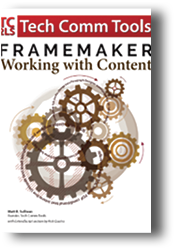 FrameMaker – Working with Content is an in-depth reference manual that explores the nooks and crannies of the Adobe FrameMaker 2017 authoring and publishing tool. As a reference manual, this behemoth publication is easy to open and use on a desk, compared to a smaller book that increases the number of pages and is difficult to keep open and control.
FrameMaker – Working with Content is an in-depth reference manual that explores the nooks and crannies of the Adobe FrameMaker 2017 authoring and publishing tool. As a reference manual, this behemoth publication is easy to open and use on a desk, compared to a smaller book that increases the number of pages and is difficult to keep open and control.
Sullivan organizes this book into progressive overview parts (Part I to Part VII) with chapters covering specific topics. These overview parts include Getting Started with FrameMaker (I), Creating and Manipulating Text (II), Controlling Page Layout (III), Building Books (IV), Creating Output (V), Advanced Techniques (VI), and Appendixes (VII). For example, Part II, Creating and Manipulating Text includes chapters on “Word Processing Features” and “Templates.” Additionally, each chapter has a mini-table of contents which drills down into chapter details and is helpful to find related content. The advantage to this type of organization is the linear flow that progresses from beginning to more advanced concepts and features that allows the novice and expert to look up tasks or reference material according to expertise. When in doubt, the index is a great resource.
FrameMaker – Working with Content is more than just a reference manual, however, as Sullivan provides sage advice throughout the book regarding best practices, how the FrameMaker features work, what to avoid, workarounds, and helpful notes. An example is the visual folder structure he suggests that clients use for project file storage (pp. 63–64). And, while I am advanced in FrameMaker use, to build a new table of contents (TOC) has a way of flummoxing me, so I use step-by-step guidance, and appreciate Sullivan’s advice on how to avoid formatting work when creating a TOC (p. 287) and other expert tips on customization, reference flows, and TOC flow entries.
Listings of “new features,” starting with FrameMaker 9, describe the features by version. Chapters of the book describe each new feature version as well. This is helpful information, especially if you use an older version of the tool, are curious about the version in which the feature appears, or want to look up the current new features.
I enjoy the navigation icons including notes, education, tutorials, and more. My favorite icon, though limited in use, provides access to training videos on the Tech Comm Tools website. Each mini-video demonstrates how to apply or use a FrameMaker feature and is accompanied with a script. Seeing a video cements the learning experience.
Sullivan could improve upon the book’s content by adding a legend describing the icons (notes, checkmarks, and exclamation points) as these are not intuitive and tend to blend together. Another improvement suggestion is to use consistent headings and table titles as I found many instances of initial caps and title case used randomly.
In conclusion, FrameMaker – Working with Content is not necessarily an easy read, but the organization and content of Sullivan’s manual reveals a lifetime of FrameMaker experience and demystifies the hidden layers of a complicated tool.
Maralee Sautter
Maralee Sautter has more than 18 years of technical communication experience. She is an Associate Fellow and past president (twice) of STC Willamette Valley Chapter and past co-manager of the Instructional Design & Learning SIG. She teaches evenings and online at Portland State University in Portland, Oregon, and holds local contracting positions.
Topic-Driven Environmental Rhetoric
Derek G. Ross, ed. 2017. New York, NY: Routledge. [ISBN 978-1-138-21656-3. 278 pages, including index. US$150.00.]
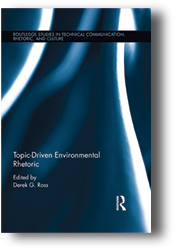 Issues surrounding the environment affect our daily lives and are highly political as seen by debates on climate change, toxic waste storage, and water conservation. There is no shortage of studies that analyze the environmental rhetoric in these debates and other related disputes; however, in Topic-Driven Environmental Rhetoric, Ross and contributors analyze “topic-driven argumentation” and commonplaces in ongoing discussions concerning the environment—discussions that have political, social, ethical, and scientific implications. This collection’s purpose is to help readers take a step back to see the larger picture of the arguments that motivate and drive actions regarding environmental concerns. By analyzing “the way that topics shape the decision-making process and help construct proof” (p. 1), we can see the “power and potential in this rhetorical tool” (p. 3). “Thus, stakeholders’ uses of topic-driven arguments also work to establish their vision of which values should be prioritized in society, what counts as evidence, and what actions should or should not be taken” (p. 188). I cannot think of a more timely, crucial topic for readers to explore than the ways that arguments, our own as well as those of others, about the environment are constructed because of the grave consequences and the need for “new avenues for research, new approaches to communication, and new ways to consider our ever-evolving understanding of rhetoric” (p. 18). Ross and the other contributors deliver powerful messages in this vein.
Issues surrounding the environment affect our daily lives and are highly political as seen by debates on climate change, toxic waste storage, and water conservation. There is no shortage of studies that analyze the environmental rhetoric in these debates and other related disputes; however, in Topic-Driven Environmental Rhetoric, Ross and contributors analyze “topic-driven argumentation” and commonplaces in ongoing discussions concerning the environment—discussions that have political, social, ethical, and scientific implications. This collection’s purpose is to help readers take a step back to see the larger picture of the arguments that motivate and drive actions regarding environmental concerns. By analyzing “the way that topics shape the decision-making process and help construct proof” (p. 1), we can see the “power and potential in this rhetorical tool” (p. 3). “Thus, stakeholders’ uses of topic-driven arguments also work to establish their vision of which values should be prioritized in society, what counts as evidence, and what actions should or should not be taken” (p. 188). I cannot think of a more timely, crucial topic for readers to explore than the ways that arguments, our own as well as those of others, about the environment are constructed because of the grave consequences and the need for “new avenues for research, new approaches to communication, and new ways to consider our ever-evolving understanding of rhetoric” (p. 18). Ross and the other contributors deliver powerful messages in this vein.
The book is divided into four common topics: framing, place, risk and uncertainty, and sustainability. Framing is concerned with how rhetoric shapes environmental discourse where contributors explore perceptions of proof, of scientists as heroes, and of the term “environmentalist.” The section on Place discusses how place influences audiences and their understanding of environmental debates through arguments that use the apocalypse, protection of land and people, and identity as commonplaces. Topic-driven arguments used to communicate risk and get to the “truth” of environmental matters are analyzed in Risk and Uncertainty through case studies on how accident reports can be used as preventative measures for future environmental disasters rather than as vehicles that try to pinpoint one cause and implicate blame, how apparent decolonial feminism is used as an approach to understand risk communication, and through the manufacture of doubt in hydraulic fracking debates. And scrutiny over the “confused notions” (p. 224) and obscure definitions of the terms “sustainability” and “sustainable development” is the focus of Sustainability.
Topic-Driven Environmental Rhetoric is a deliberate and superb collection of argument analysis on environmental matters. I found this anthology to be a page-turner, because I appreciated the inclusion of chapters on high profile environmental matters that are difficult to understand through mainstream media alone, and the thorough research, background, and analysis covered by each contributor that helped me understand the complexities of those issues. The unique, topic-driven argument angle clearly demonstrated how such arguments shape global politics on many issues that have definite effects on our lives now and will affect the future. I highly recommend this book for technical communication scholars, graduate students, and practitioners.
Diane Martinez
Diane Martinez is an assistant professor of professional and technical communication at Western Carolina University. She previously worked as a technical writer in engineering, an online writing instructor, and an online writing center specialist. She has been with STC since 2005.
Draft No. 4: On the Writing Process
John McPhee. 2017. New York, NY: Farrar, Straus and Giroux. [ISBN 978-0-374-14274-2. 192 pages. US$25.00.]
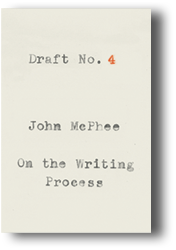 Creative nonfiction, long form journalism, whatever you call it, McPhee has been its acknowledged master for more than half a century. With more than 100 New Yorker articles and 30 books, all still in print, a Pulitzer, and a long career teaching his craft to writing students at Princeton, McPhee is known for his interesting subjects, unique research methods, and superb craftsmanship.
Creative nonfiction, long form journalism, whatever you call it, McPhee has been its acknowledged master for more than half a century. With more than 100 New Yorker articles and 30 books, all still in print, a Pulitzer, and a long career teaching his craft to writing students at Princeton, McPhee is known for his interesting subjects, unique research methods, and superb craftsmanship.
From time to time, McPhee has shared his insights and experience of the writing life in The New Yorker. With Draft No. 4: On the Writing Process, nine of those articles are now available in book form.
What sets the Draft No. 4 apart from other writing advice is that it is truly about the writing process: how McPhee goes about doing what he does. The title is taken from McPhee’s essay on the importance of rewriting, finding the better word, and selecting not just what to keep, but what to leave out. McPhee says it is usually not until draft number 4 that he knows he’s done; he hits a point where he knows he can’t do any better.
Drawing on his own observations of the growth of his own craft and development as a writer, McPhee touches all the bases: choosing a subject, finding an organic structure that will give shape to the piece, managing the copious material that must be gathered for a long work, handling difficult interviewees, working with editors and fact checkers, and much more.
McPhee’s favorite method of working is to embed himself in a situation—often for weeks—and watch people work. He has hiked with geologists, crossed the country with long-haul truckers, investigated modern day rustling with agricultural law enforcement, and much more. Having immersed himself in an experience, he discovers what he doesn’t know, and this then drives further reading and interviewing, until he has fully explored his subject.
From his own experience both as a writer and a teacher, he stresses that becoming a writer is a process of discovery. Early on, as a budding writer, you need to discover what kind of writer you are; you should to try different genres until you find the right fit. You can only find out through trying.
While there is much here for professional writers to ponder, like a good conversation among fellow professionals, the articles are, in fact, written for a general audience. McPhee makes many of his points by telling stories from his life, and quoting sections from his work. He tells a very funny story about interviewing Jackie Gleeson, while Gleeson’s friends were attempting to convince him not to cooperate. (To find out how it worked out, read the book.) He also has great tales of working with various editors and The New Yorker’s famed fact checkers.
Draft No. 4 is a rich, valuable, and thoroughly enjoyable book.
Patrick Lufkin
Patrick Lufkin is an STC Fellow with experience in computer documentation, newsletter production, and public relations. He reads widely in science, history, and current affairs, as well as on writing and editing. He chairs the Gordon Scholarship for technical communication and co-chairs the Northern California technical communication competition.
Now You See It and Other Essays on Design
Michael Bierut. 2017. New York, NY: Princeton Architectural Press. [ISBN 978-1-61689-624-9. 240 pages, including index. US$35.00.]
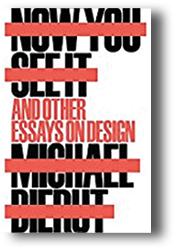 As a creative in the design industry, I understand the insecurities and doubt that plague this industry. In Bierut’s new book, he shows us that he understands it too. This curated series of 54 previously published essays sculpts out an autobiographical story of a living design legend. From discouragement to enthusiasm and everything in between, Bierut shares an inside look at what every designer faces and, in so doing, lets us know we are not alone.
As a creative in the design industry, I understand the insecurities and doubt that plague this industry. In Bierut’s new book, he shows us that he understands it too. This curated series of 54 previously published essays sculpts out an autobiographical story of a living design legend. From discouragement to enthusiasm and everything in between, Bierut shares an inside look at what every designer faces and, in so doing, lets us know we are not alone.
As we move through the beginning of the book, we get a sense of nostalgia, as Bierut describes the days of a more deliberate design process before computers changed the world. He takes us on a tour of his life as a designer, allowing us to stop and look at some of the great moments that influenced him and meet some design giants along the way. These personal accounts let us experience the matte black office accessories at the Vignelli studio as he shares the enormous impact both Massimo and Lella had on him and how it has affected him throughout his career. We move on to see him experiment promiscuously with typography and his humility in dealing with color as he highlights projects that pushed him to grow through struggle, failure, and success. We also get an up-close look at the unflinching political arena via the Hillary logo design, and its very public critique.
With an unassuming tone, Bierut provides us with an entertaining array of topics, that seemingly transcend the topic of design, but as we make our way through an assortment of interviews, observations, book introductions, award ceremony speeches, we see design’s reach through each essay.
Any designer would be drawn to the clever approach of the cover design—a modern simplicity with a cheeky undertone sets the pace for the interior, both in content and design. With his life spread across the beautifully laid out pages, we are witness to what he has learned over the years. While we can learn from all his realizations and lessons, the biggest takeaway that Michael Bierut gives us is a sense of comfort. This is a story of optimism and curiosity disguised as a book of design essays—an entertaining and encouraging account for those in any creative industry.
Lanie Gabbard
Delana (Lanie) Gabbard is an associate professor of graphic design with a specialty in typography at the University of Central Oklahoma after several years of working professionally as a graphic designer. She is an award-winning designer and has been published academically and online.
Never Use Futura
Douglas Thomas. 2017. New York, NY: Princeton Architectural Press. [ISBN 978-1-61689-572-3. 208 pages, including index. US$24.95 (softcover).]
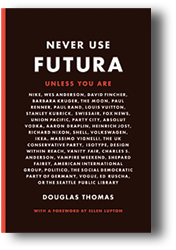 Never Use Futura is a book that Thomas began as a quest to answer a question that had troubled him since his undergraduate studies in design at Brigham Young University. That question was, Why are design students often told by their professors not to use Futura, a ubiquitous font, despite the evidence that it has been used widely in designs throughout history, and even today, by both prominent and highly regarded designers? This book is the result of an extensive historical analysis into the use of Futura presented through a collection of essays. The essays fit nicely together to paint a picture of the use of Futura, and the focus sets it apart from other recent texts about Futura, which concentrate more on the typeface’s design and revolutionary theories that impacted designer Paul Renner and its development. A renewed interest in Futura in the past year is because of the typeface’s 90th anniversary in 2017.
Never Use Futura is a book that Thomas began as a quest to answer a question that had troubled him since his undergraduate studies in design at Brigham Young University. That question was, Why are design students often told by their professors not to use Futura, a ubiquitous font, despite the evidence that it has been used widely in designs throughout history, and even today, by both prominent and highly regarded designers? This book is the result of an extensive historical analysis into the use of Futura presented through a collection of essays. The essays fit nicely together to paint a picture of the use of Futura, and the focus sets it apart from other recent texts about Futura, which concentrate more on the typeface’s design and revolutionary theories that impacted designer Paul Renner and its development. A renewed interest in Futura in the past year is because of the typeface’s 90th anniversary in 2017.
Never Use Futura begins with a brief yet witty introduction by noted author, designer, and educator Ellen Lupton, where she helps set the stage for Thomas’s book. In exploring the prolific nature of the typeface, the book’s essays cover a range of topics from the typeface’s use in politics, its place in modernism and modern design, and in consumerism, as well as its use on the moon and in space exploration. Thomas also investigates Futura’s place in visual language, both historically and currently. One other important thing to note is the book’s discussion of Futura’s many clones, which gives insight not only into the font’s ubiquitous nature but also the prevalence of its knockoffs and clones. It may be shocking for some readers to find that their most beloved fonts were commissioned solely to compete with the success of this remarkable geometric sans serif. Many fonts, even today, owe their heritage to Futura, even if they are not exactly reproductions.
Thomas wrote this text as his MFA thesis while at Maryland Institute College of Art (MICA), and the result is a resounding success. His background, not only in graphic design but in history as well, make this a very well-informed first book. Never Use Futura is well written, entertaining, and informative. The book will appeal to anyone with an interest in graphic design, design history, or typography. Also included is a collection of images as examples of Futura’s use and prevalence throughout history. A discrepancy, however, is with the images alternating between black and white and either a blue or a red duotone. While the black and white images work well, the duotone images are somewhat distracting from the content. Thomas posits in the book that “Typography is legitimacy” (p. 140). It seems that, if used appropriately, Futura can lend your design legitimacy.
Amanda Horton
Amanda Horton holds an MFA in Design and currently teaches graduate and undergraduate courses at the University of Central Oklahoma in the areas of design technology, design studio. and history of graphic design. Ms. Horton is also the director of the Design History Minor at UCO.
Out of the Ruins: The Emergence of Radical Informal Learning Spaces
Robert H. Haworth and John M. Elmore, eds. 2017. Oakland, CA. PM Press. [ISBN 978-1-62963-239-1. 284 pages, including index. US$24.95 (softcover).]
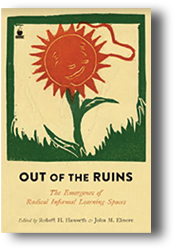 Out of the Ruins: The Emergency of Radical Informal Learning Spaces is an edited collection with its guiding concept of Radical Informal Learning offering thirteen chapters, thirteen different approaches, for actively teaching and educating against authoritarian institutions, policies, and practices. Some chapters are idealistic while others are confrontational; several chapters offer subtle but potentially effective strategies to work against the corporatized and surveilled learning environments where so many of us work and teach.
Out of the Ruins: The Emergency of Radical Informal Learning Spaces is an edited collection with its guiding concept of Radical Informal Learning offering thirteen chapters, thirteen different approaches, for actively teaching and educating against authoritarian institutions, policies, and practices. Some chapters are idealistic while others are confrontational; several chapters offer subtle but potentially effective strategies to work against the corporatized and surveilled learning environments where so many of us work and teach.
Four sections nicely divide the book and scaffold effectively. First: critiques of education. Elmore’s “Miseducation and the Authoritarian Mind” is one of the strongest pieces in the text; it sets the book’s tone. This work will probably be reprinted in multiple future collections—thus, this is the key piece to take from this collection. Next section: “Theoretical Frameworks for Educational Praxis.” Blending an array of critical pedagogues, anarchists, anti-colonialists, and related revolutionaries, these chapters’ authors offer multiple structures and frameworks to move against abusive power.
The third section is likely most relevant to technical communication readings: using official institutional space for radical learning while not being of the space. Resistance from within the system. Sadly, no chapter was entirely persuasive. In their favor, each chapter represents a practical, hands-on approach to making their theory live and real. As such, their suggestions and insights need not be either effective or persuasive; what matters is that they shared tactics and experiences and allow us to learn from their work. That sharing in community is what is most notable. From that view, this section succeeds.
The last section, “Of the Streets and the Coming Educational Communities,” offers four chapters about ways to engage, teach, and learn outside of the university. This section is most interesting because it blends direct experience, such as working in Anarchist Free schools or developing horizontal pedagogy, with visions of the future. In a sense, they are forecasting or planning a bit, but this planning is not based just on theories—it’s based on work that they are already engaged in.
Anarchism has long attended to education’s importance in social relations and liberation. Sadly, scholarship around these ideas has been limited, often despite the explicit parallels between anarchism and liberatory educators like Ivan Illich and Paulo Freire or John Dewey’s experiential education and learning. Out of the Ruins is a welcome addition. It contributes both in terms of scholarly work as well as helping share practical and theoretical pieces for those interested in challenging extremist authoritarianism.
Gregory Zobel
Gregory Zobel is an assistant professor of Educational Technology at Western Oregon University.
Communicating Genetics: Visualizations and Representations
Han Yu. 2017. London, United Kingdom: Palgrave Macmillan. [ISBN 978-1-137-58779-4. 271 pages, including index. US$ 99.99.]
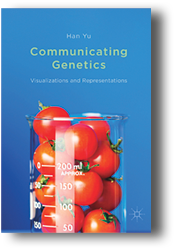 Genetic science is no longer a futuristic endeavor. It already has produced genetically modified food, animals, and trees; genetic testing is used in disease prediction and prevention; and, genetic sequencing is used to “explore health risks and develop personalized medical and lifestyle protocols” (p. 254) and provide family history. Genetic science is experienced daily on individual levels, but how much does the average individual really understand about genetics, especially when science, in general, relies on visuals to communicate complex information to publics? Communicating Genetics: Visualizations and Representations is a thoughtful, important book that goes beyond theoretical discussion about visual representation of genetics. Yu provides readers with critical analysis of over 100 years’ worth of visuals related to genetics and “discusses the potential impact on the US publics’ uptake of genetics” (p. 2).
Genetic science is no longer a futuristic endeavor. It already has produced genetically modified food, animals, and trees; genetic testing is used in disease prediction and prevention; and, genetic sequencing is used to “explore health risks and develop personalized medical and lifestyle protocols” (p. 254) and provide family history. Genetic science is experienced daily on individual levels, but how much does the average individual really understand about genetics, especially when science, in general, relies on visuals to communicate complex information to publics? Communicating Genetics: Visualizations and Representations is a thoughtful, important book that goes beyond theoretical discussion about visual representation of genetics. Yu provides readers with critical analysis of over 100 years’ worth of visuals related to genetics and “discusses the potential impact on the US publics’ uptake of genetics” (p. 2).
The book is appropriately organized according to view: photographic, microscopic, illustrated, code, graph, and structural. Each chapter provides a historical progression of visuals according to each type of view. Even more interesting is Yu’s analysis on how these images “embody value judgments about the subject matter they portray and thus influence readers not only cognitively but affectively” (p. 12). Yu approaches her analysis on the basis that genetic visuals are “socio-cultural artifacts” (p. 11), and she is concerned with how accessible these visuals are to the average non-expert reader who is not “elite,” “educated,” or a science “fan” (p. 12). For instance, classical genetics (1900–1940) photographs focused on visible phenomena (such as the different color of mice), but when DNA entered the mainstream discussion about genetics, photographs became more entertaining because they had to relay what was happening at the molecular level. While photographs became more aesthetically pleasing and attention-getting, the visuals did not increase the public’s understanding of genetics or engage viewers in any type of scientific dialogue. In some ways, the visuals even reduced thinking about genetics through “genetic essentialism” or “neurogenetic determinism” (p. 56) where photographs reduce humans to their genetic makeup through popular images that depicted certain people as “victims” of genetic diseases.
As the world and, most especially, science becomes more complex, writers and publishers rely on visuals to communicate complicated information to non-expert audiences; however, as Yu points out, those visuals are not always effective. One strength of Communicating Genetics is that Yu explains why certain visuals fail or succeed in the context in which they are used, and she offers suggestions for how they could be made more useful. She also identifies areas that need more research. The only drawback to this book was its black and white images. There are notes in the book that color images are available online, but I could not find where they reside. Regardless, I highly recommend this book for science and technical communication graduate students (even if they are not studying scientific communication) and scholars and practitioners in these fields as well. I make this recommendation not only because of the important subject matter regarding genetics, but anyone who has a hand in creating visuals can benefit from this excellent study.
Diane Martinez
Diane Martinez is an assistant professor of professional and technical communication at Western Carolina University. She previously worked as a technical writer in engineering, an online writing instructor, and an online writing center specialist. She has been with STC since 2005.
Graphic Design Discourse: Evolving Theories, Ideologies, and Processes of Visual Communication
Henry Hongmin Kim, ed. 2017. Hudson, NY: Princeton Architectural Press. [ISBN 978-1-61689-558-7. 456 pages. USD$45.00 (softcover).]
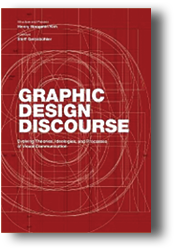 Kim and his collaborators have assembled an impressive anthology of texts that span the millennia and form the dialogue that has shaped and informed design over time. Graphic Design Discourse: Evolving Theories, Ideologies, and Processes of Visual Communication, will undoubtedly find its way into graduate-level visual communication courses and into the hands of designers who have an interest in theory and design philosophy.
Kim and his collaborators have assembled an impressive anthology of texts that span the millennia and form the dialogue that has shaped and informed design over time. Graphic Design Discourse: Evolving Theories, Ideologies, and Processes of Visual Communication, will undoubtedly find its way into graduate-level visual communication courses and into the hands of designers who have an interest in theory and design philosophy.
In some ways, this book would be perfectly suited in any graduate rhetoric class. The mantra of “design is everything, and everything is design” echoes the stance that “everything is rhetoric.” As such, it’s no surprise that we find texts commonly studied in rhetoric classes, as Aristotle’s “Rhetoric,” Foucault’s “What is an Author?”, Barthes’ “Elements of Semiology,” Benjamin’s “The Work of Art in the Age of Mechanical Reproduction,” and many more. The difference between this and texts traditionally used in rhetoric and composition courses is the addition of texts that deal not with textual composition and professional writing, but rather texts written by designers and architects, which provides a rich, refreshing perspective.
Besides the traditional rhetorical texts, Kim includes articles and essays written by such influential designers as Paul Rand and Massimo Vignelli. Through the texts, Kim traces the conversations chronologically through nine categories or “processes.” The processes represent the different conversations taking place about modernism, postmodernism, authorship and legitimacy, ethics, and creative process. For Kim, design means much more than a noun (the visual aesthetic); it’s a verb (encompassing critical thinking, problem solving, development, and communication). Thus, rather than sections or chapters, this collection is arranged by process. Kim provides a short introduction to each process and imparts insight into how he sees the various texts relating to each other to form a continual dialog.
While Graphic Design Discourse constitutes an impressive assemblage of articles and essays, it seems to struggle with its own identity. It’s not sure whether it wants to be a design book or an anthology. On one hand, it tries to treat the text in unusual ways (the sideways, right-aligned text on page 21; the ridiculously footnoted text on pages 13, 43, and 323; sudden columns on 119; text in different directions on 155), but these treatments aren’t consistent enough to create a sense of cohesion, nor are they frequent enough to give the reader that visual eye candy that seems to be the hallmark of design books. Anthologies, on the other hand, are meant to be read, and superfluously designed text is distracting and impairs readability.
Thankfully, these design choices were only applied to Kim’s own interjections. The texts selected for inclusion are left intact and were not subject to similar distracting and unnecessary design. The texts that were so carefully assembled for Graphic Design Discourse, rather than the design of the volume, serve as an important body of knowledge for graphic designers, rhetoricians, and philosophers.
Michael Opsteegh
Michael Opsteegh is an STC Senior Member and a technical writer in the software and financial services industries since 2004. He is a lecturer in the technical communication program at Cal State Long Beach. Michael holds a master’s degree in English and is a Certified Technical Professional Communicator (CPTC).
This Book is a Planetarium and Other Extraordinary Pop-Up Contraptions
Kelli Anderson. 2017. San Francisco, CA: Chronicle Books LLC. [ISBN 978-1-4521-3621-9. 10 pages. USD$40.00.]
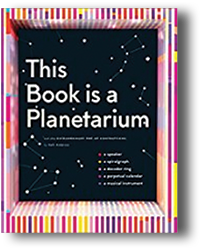 When selecting a book by title alone, you may think that This Book is a Planetarium and Other Extraordinary Pop-Up Contraptions may be a generalization about the book’s contents. Perhaps the book is about planetariums, projecting stars, or constellations. However, in this case, the book folds out to become a rudimentary planetarium, powered by the light of a cell phone or other small flashlight.
When selecting a book by title alone, you may think that This Book is a Planetarium and Other Extraordinary Pop-Up Contraptions may be a generalization about the book’s contents. Perhaps the book is about planetariums, projecting stars, or constellations. However, in this case, the book folds out to become a rudimentary planetarium, powered by the light of a cell phone or other small flashlight.
Not only is this book a planetarium, it is also a musical instrument, decoder ring, perpetual calendar, speaker, and spiralgraph. Each is made almost exclusively from folded paper or paper board, and all the advertised items are functional. As you unfold each page, easy to follow instructions appear, along with a brief explanation of the paper device.
First is a musical instrument: a simple guitar with nylon strings, and a paperboard pick held in place by a sturdy paper strip. Although you cannot play actual music on the makeshift guitar, you can pluck the strings and here the different intonations created by the length and tautness of the strings. Next up is the basis of all simple cryptography: the decoder ring. The ring consists of a spinning disk with letters and numbers on it, along with a description on how to use it. Sharing the page spread is a perpetual calendar. A perpetual calendar uses similar mechanics as the decoder ring and consists of an inset disk that you spin to show the relationship between years and days of the week. For example, in 2012, January and October have a Monday that is the first day of the month. On the same setting, you’ll see that 2034 has May starting with a Monday as the first of the month. Other month/day combinations appear on the same display as well. When you get to a new month, you turn the dial, and the calendar recalibrates itself according to the year/month selection you make.
A titular planetarium appears in the center of the book. This is one of the book’s more complicated paper-folding creations. On the tips of the front and back inside covers of the book are elastic bands. You can use them to loop over the interior pages of the planetarium, enabling you to keep the book open and flat. Once the pages are secured, you are invited to place a small light, such as from a cell phone, under the planetarium dome. When taken into a darkened room, your ceiling will be flooded with stars along with lines connecting the constellations. These constellations are named, but not described.
The last pages contain a folding cone and stand for a cell phone. The cone will act as a sound channeling device for any noise or music created on the mobile device. This Book is a Planetarium concludes with a spiralgraph. This is a spot to place a piece of paper and hold it down with a cutout of a giant gear. On the opposite page there are 4 smaller gears stored behind thick paper straps. Each gear has many off-center holes in them. When placed in the cogs of the giant gear, over the pinned paper, you can trace a pen or pencil in any of the holes while rolling the small gear around the teeth of the giant gear. The result of this rolling is an enticing pattern of predictably wavy lines. If you keep a firm grip on the giant gear, the smaller gears will smoothly roll around creating mathematical artwork.
With This Book is a Planetarium, Anderson created a visually engaging, informative book that families will enjoy. My preschooler regularly requests that we set up the planetarium in his room at night, and if he can play the guitar in the book. If you are looking for instructions on how to build these items, then this is not the right book for you. Conversely, if you seek clever demonstrations of paper folding to build intriguing devices to share with your family, then This Book is a Planetarium can help you reach the stars.
Timothy Esposito
Timothy Esposito is an STC Associate Fellow with over 15 years of technical communication experience. He is currently president of the STC Philadelphia Metro Chapter and chair of the Distinguished Community Service Award Committee. Before becoming president, Timothy was chapter vice president, treasurer, webmaster, and scholarship manager.
Visual Journalism: Infographics from the World’s Best Newsrooms and Designers [English Translation]
Javier Errea, ed. 2017. Berlin, Germany: Gestalten. [ISBN 978-3-89955-919-4. 288 pages, including index. USD$69.00.]
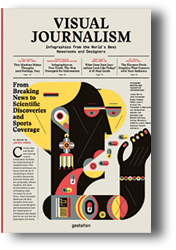 Every day, we’re bombarded with massive amounts of information from fluctuations in stock prices, census data, population health, food and energy costs, crime rates, and more. As content consumers, we’re expected to make sense of all this big data. Both the amount of information and advancements in the technologies used to visualize data have led to a proliferation of infographics in newspapers, magazines, the Web, video, and social media. These factors have also led to more creative and complex infographics. Visual Journalism: Infographics from the World’s Best Newsrooms and Designers chronicles this “golden age” of information graphics, or infographics.
Every day, we’re bombarded with massive amounts of information from fluctuations in stock prices, census data, population health, food and energy costs, crime rates, and more. As content consumers, we’re expected to make sense of all this big data. Both the amount of information and advancements in the technologies used to visualize data have led to a proliferation of infographics in newspapers, magazines, the Web, video, and social media. These factors have also led to more creative and complex infographics. Visual Journalism: Infographics from the World’s Best Newsrooms and Designers chronicles this “golden age” of information graphics, or infographics.
Although Errea didn’t set out to create a beautiful book, that’s exactly what he did. The infographics presented throughout Visual Journalism are arresting, absorbing masterpieces of data visualization. This volume, however, represents more than mere “chart porn,” Errea has painstakingly profiled such current masters and rising stars of infographics as Amanda Cox, Mónica Serrano, Archie Tse, and 15 others. The profiles describe not only the artists’ careers and educations, but also their passions and processes. These profiles present a study of how infographic designers think about the world and shape large data sets. The book also features analysis and commentary from eight global infographic designers, which add important context about how infographics educate and shape the world.
Visual Journalism was originally printed in Germany and, as such, takes a distinctly world view of infographics. The designers featured and the works illustrated are representative of nearly every continent. And while the profiles, commentaries, and captions are translated into English, the infographics themselves are presented in their native languages. It’s interesting to observe how much information is communicated through the visualizations without reading the text. It’s also interesting to observe how often visualizations can be confounding without it. Visual Journalism is surprisingly current, and features infographics from 1979 all the way through 2017. The casual reader might be surprised to find current events present in a book that must have taken considerable time to produce.
Visual Journalism is simply gorgeous. Its generous size (10.9×13.2″) is suitable for reproducing works that originally appeared on large tabloid sheets. The infographics are brilliantly printed in full color, and four of the larger infographics fold out to accommodate larger infographics. It’s possible to flip to any page and instantly lose yourself for an hour, tracing the charts and graphs through their various windings, connecting data points, and making meaning. Such is the power of infographics.
The book’s large format has some drawbacks. It becomes unwieldy to turn the book to read text printed sideways, and the book’s own captions are often printed sideways. The book also lacks a table of contents and a subject index (although, it does include an index of designers and commentators). The lack of these navigational features might prove frustrating to researchers more than casual readers.
Michael Opsteegh
Michael Opsteegh is an STC Senior Member and a technical writer in the software and financial services industries since 2004. He is a lecturer in the technical communication program at Cal State Long Beach. Michael holds a master’s degree in English and is a Certified Technical Professional Communicator (CPTC).
How to Write and Present Technical Information
Charles Sides. 2017. 4th ed. Greenwood. 244 pages, including index. [ISBN 978-1-4408-5505-4. USD$61.00.]
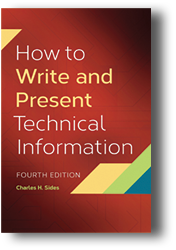 How does Charles Sides update his How to Write and Present Technical Information book to bring it to its fourth edition? He starts with the idea that technology is now a dominant force in professional communications and the audience should learn to maximize the impact of technology to create effective information products.
How does Charles Sides update his How to Write and Present Technical Information book to bring it to its fourth edition? He starts with the idea that technology is now a dominant force in professional communications and the audience should learn to maximize the impact of technology to create effective information products.
With this update, this book becomes a valuable textbook or reference for today’s audiences, covering newer tools such as social media, Skype, and Webinars while still covering the basics and older tools still in use today, including topics such as the Flesch Readability Scale and Gunning Fog Index (pp. 189–191). Sides covers both text and spoken presentations and how effective communication can have a positive impact on project management in professional environments.
With Sides working as a professor of communication and director of internships for the Department of Communications Media at Fitchburg State University, he has a good idea of what should go into How to Write and Present Technical Information to continue to make it an asset for today. He is also a consultant, editor of the Journal of Technical Writing and Communication, and editor of the Baywood Series in Technical Communication, giving him a valuable perspective on what information is of value to the audience.
Scientists and engineers could benefit from How to Write and Present Technical Information as it covers the basics of gathering information, keeping the focus on what the audience needs, editing, and making presentations. Information on how to write public relations, marketing, and advertising materials also appears and is of value to the audience if they need to prepare such information. Communicators and students could also benefit from the overview.
Jeanette Evans
Jeanette Evans is an STC Associate Fellow and active in the NEO community, currently co-authoring an Intercom column on emerging technologies in education. She holds an MS in technical communication management from Mercer University. Jeanette currently freelances, tapping into her eclectic background and interests.
Making Books: A Guide to Creating Handcrafted Books
London Centre for Book Arts. 2017. New York, NY: Princeton Architectural Press. [ISBN 978-1-61689-631-7. 192 pages. USD$35.00.]
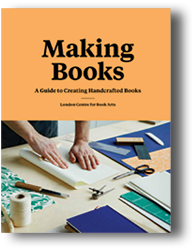 When I first looked at Making Books: A Guide to Creating Handcrafted Books, I wondered if technical communicators would even be interested in it. Hundreds of books are available that speak directly or indirectly to the main work they do: develop content. Some books that discuss design mention designing books. Making Books tells about binding the book once the content is set, the designers have finished, and it is printed.
When I first looked at Making Books: A Guide to Creating Handcrafted Books, I wondered if technical communicators would even be interested in it. Hundreds of books are available that speak directly or indirectly to the main work they do: develop content. Some books that discuss design mention designing books. Making Books tells about binding the book once the content is set, the designers have finished, and it is printed.
For the typical technical communicator, however, knowing how books are bound could enhance their contributions to the whole process.
But the value of this book will appeal to other potential readers that could include someone looking for a hobby. Or, persons looking for an evening activity that might turn into a second or even primary job. Or, someone who owns some old books that need to be rebound. And many others.
The authors founded the London Centre for Book Arts. Their mission, both at the Centre and in their book, is to provide instruction for bookbinding. They assume that their readers know nothing about the craft and want to do it at home.
The “Introduction” explains the history and goals of the Centre, stressing that members can come and use their equipment, but that is not the full story. They want their readers to be able to do bookbinding at home. After a brief overview of binderies, they present the list of tools and equipment, materials needed, and techniques involved for all projects.
A large section describes various kinds of bookbinding including not just traditional bookbinding, but also pamphlets, stab bindings, slim case bindings, and more. Each section contains photographs showing what the section describes. These photographs are especially useful not only for the tools and equipment used, but also the step-by-step instructions for the different binding types.
Each project begins with a materials list and required tools. Illustrations show how to develop the finished product with a completed project also illustrated. Drawings of the stitching patterns show how to do that part.
In stab bindings, for example, the stitching is seen on the outside of the project rather than being hidden behind the cover. It is a technique developed by the Japanese many centuries ago and adds a decorative feature to the project.
While technical communicators who follow a classical approach to instructions will find fault in the authors’ approach, such differences do not distract. Paragraphs, for example, that show specific steps may contain more than one activity. Also, the photographs of the steps do not provide call-outs found in the classical approach. Neither difference, however, interferes with understanding what to do.
Making Books: A Guide to Creating Handcrafted Books is well worth the cost for those readers I mentioned above, and at a minimum show how to bind various documents when the project calls for a book.
Tom Warren
Tom Warren is an STC Fellow, Jay R. Gould Award for Excellence recipient, and professor emeritus of English (technical writing) at Oklahoma State University, where he established the BA, MA, and PhD technical writing programs. Past president of INTECOM, he served as guest professor at the University of Paderborn, Germany.
A World without “Whom”: The Essential Guide to Language in the BuzzFeed Age
Emmy J. Favilla. 2017. New York, NY: Bloomsbury. [ISBN 978-1-63268-757-5. 392 pages, including index. US$26.00.]
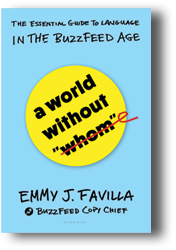 To start with, I had not heard of BuzzFeed before I read A World without “Whom”: The Essential Guide to Language in the BuzzFeed Age, so it says something about the reviewer. But fortunately, Favilla has me in mind when she writes, “You might not want to make the effort to learn more, or to care, about how people decades younger than you are conversing” (p. 311). Actually, I do care, so that is why I read and reviewed this book.
To start with, I had not heard of BuzzFeed before I read A World without “Whom”: The Essential Guide to Language in the BuzzFeed Age, so it says something about the reviewer. But fortunately, Favilla has me in mind when she writes, “You might not want to make the effort to learn more, or to care, about how people decades younger than you are conversing” (p. 311). Actually, I do care, so that is why I read and reviewed this book.
Favilla, the Copy Chief at BuzzFeed, has a similar background to many technical writers, though she is not aware of us as an audience. Her life as a copyeditor is an “accidental livelihood”; “I am a person who happened to stumble into a career in copyediting by way of my journalism degree” (p. 2). How many of us can say that!
There are so many good things to write about A World without “Whom”, it’s hard to know where to start. There are four chapters I’d like to mention. First, Chapter 4: “How Not to Be a Jerk,” talks about how language influences reality, so we better be careful how we use it. “Language has the impressive ability to craft social construct, and if the result is negative, then we learn and we listen and we phrase things better the next time” (p. 60). So political correctness is not something she dismisses offhand.
Chapter 6, “How Social Media Has Changed the Game” is probably my favorite chapter, because I learned so much about how people communicate in social media. Favilla has a great sense of humor. “Doge-speak,” where photos of a Shiba Inu dog were given Comic Sans captions, is a great case in point.
Chapter 8, “How the Internet has Changed Punctuation Forever,” is the chapter I disagreed with the most. For example, this sentence made my blood boil: “Curly quotes are cool and all, but not cool enough to keep you up late worrying when there are things like, I don’t know, CLIMATE CHANGE, to think about instead” (p. 249). Since when can a person not care about punctuation and climate change at the same time? Two heroes of mine are Robin Williams (the typographer) and Bill McKibben (the climate change activist), and I think both are extremely important.
Chapter 11, “Email, More Like Evilmail, Amirite?”, is so good that I’m thinking about using the whole chapter in the Professional Writing class that I teach. She gives the subject a new slant from her youthful perspective.
I suppose the two things I’m most disappointed with in A World without “Whom” are her swearing, which is very unprofessional, and the fact that many of her radical positions are negated by the very book which she has published. It contains no comma splices, even though she says, “But it’s a new millennium and the comma splice is back—and it’s done taking shit from anyone” (p. 251). Enough said.
Charles Crawley
Charles Crawley is a long-time member of STC, who writes professionally for Rockwell Collins and teaches academically for Mount Mercy University, both in Cedar Rapids, Iowa. He will correct a comma splice and bad quotation marks, and believes in climate change.
Take My Money: Accepting Payments on the Web
Noel Rappin. 2017. Raleigh, NC: The Pragmatic Programmers. [ISBN 978-1-68050-199-5. 325 pages, including index. $38.00 (softcover).]
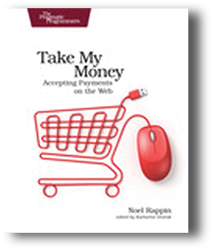 Today, businesses need to take orders and payments online if they want to survive or at least thrive. Rappin warns us that building the shopping cart can be a tortuous, frustrating venture. It includes operations like managing inventory, refunds, taking payments, validating data, security (including fraud), and reporting. Not least are the legal issues regarding online financial transactions. And things can go wrong at almost any stage of the game.
Today, businesses need to take orders and payments online if they want to survive or at least thrive. Rappin warns us that building the shopping cart can be a tortuous, frustrating venture. It includes operations like managing inventory, refunds, taking payments, validating data, security (including fraud), and reporting. Not least are the legal issues regarding online financial transactions. And things can go wrong at almost any stage of the game.
Taking payments is only a part of the entire operation. Behind that lies a complex administrative structure, plus the crucial flexibility needed to bend the rules; things always come up, that don’t fit into neat compartments.
Take My Money: Accepting Payments on the Web is written for techies, though Rappin keeps the general reader in mind. Apart from technical terms, he presupposes a knowledge of software and other Web applications that may limit the general reader’s access.
Rappin’s book uses a very accessible example for developing its Web application: the need of a small-town theater company to have an online portal for selling tickets and receiving payment. Interestingly, the portrait of this seemingly straightforward operation offers a glimpse into the transactions of a larger, more complex organization.
Let’s take a closer look at the example––the matter of tickets: Tickets are a finite resource, thus the need for inventory management. Also, the need to notify the user, track the ticket, and update totals: a workflow issue. Then, keeping an eye on sales, which involves reporting. Next, legal issues, as we’ve seen. Plus, bad things can happen with the code: the need to identify and modify bad data. Some bad things may be malicious as well: a security problem. Some bad things deliberately override the normal computer logic resulting in the need for administration.
Take My Money provides an interactive discussion forum and other aids for programmers and Web developers. Each step along the way can have a multitude of options; an idea that is well fleshed out with the ticket example for the theater company. First, the price that is modelled as an integer number of cents. In addition, the ticket’s status: sold or unsold. Perhaps an access level: some tickets may be reserved for certain users or the reservation of a specific seat to a performance given at a specific date and time. Each set may have its further subsets like the difference between general admission tickets versus specific reserved seating. And remember, we’re looking at a small-town theater company; not a multinational.
As Rappin says: “Handling payment logic is complicated, but it is also concrete and quite literally rewarding” (p. xvi). While Take My Money speaks mainly to Web designers, it provides a tremendous insight into the process of Web payments for others who are not specialists but still have a need to gain an understanding of the process.
Steven Darian
Steven Darian is an STC Fellow and retired from Rutgers University, where he taught business and technical writing. His previous book was Technique in Nonfiction: The Tools of the Trade (2017). Steven is branching out with his latest book, The Wanderer: Travels and Adventures Beyond the Pale (2018).

